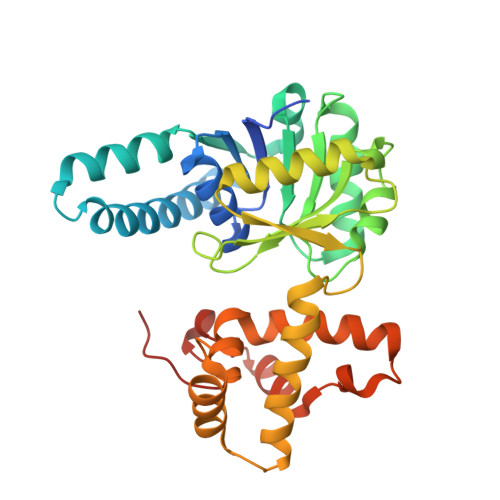Sequestration of the active site by interdomain shifting. Crystallographic and spectroscopic evidence for distinct conformations of L-3-hydroxyacyl-CoA dehydrogenase.
Barycki, J.J., O'Brien, L.K., Strauss, A.W., Banaszak, L.J.(2000) J Biol Chem 275: 27186-27196
- PubMed: 10840044
- DOI: https://doi.org/10.1074/jbc.M004669200
- Primary Citation of Related Structures:
1F0Y, 1F12, 1F14, 1F17 - PubMed Abstract:
l-3-Hydroxyacyl-CoA dehydrogenase reversibly catalyzes the conversion of l-3-hydroxyacyl-CoA to 3-ketoacyl-CoA concomitant with the reduction of NAD(+) to NADH as part of the beta-oxidation spiral. In this report, crystal structures have been solved for the apoenzyme, binary complexes of the enzyme with reduced cofactor or 3-hydroxybutyryl-CoA substrate, and an abortive ternary complex of the enzyme with NAD(+) and acetoacetyl-CoA. The models illustrate positioning of cofactor and substrate within the active site of the enzyme. Comparison of these structures with the previous model of the enzyme-NAD(+) complex reveals that although significant shifting of the NAD(+)-binding domain relative to the C-terminal domain occurs in the ternary and substrate-bound complexes, there are few differences between the apoenzyme and cofactor-bound complexes. Analysis of these models clarifies the role of key amino acids implicated in catalysis and highlights additional critical residues. Furthermore, a novel charge transfer complex has been identified in the course of abortive ternary complex formation, and its characterization provides additional insight into aspects of the catalytic mechanism of l-3-hydroxyacyl-CoA dehydrogenase.
Organizational Affiliation:
Department of Biochemistry, Molecular Biology, and Biophysics, University of Minnesota, Minneapolis, Minnesota 55455, USA.















